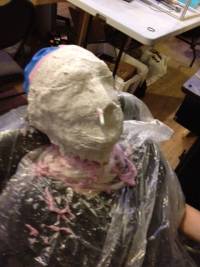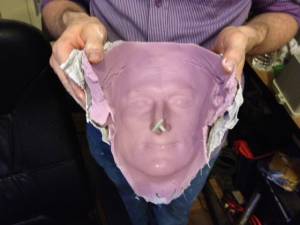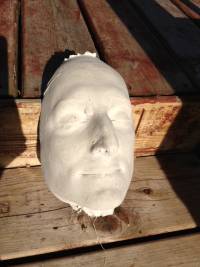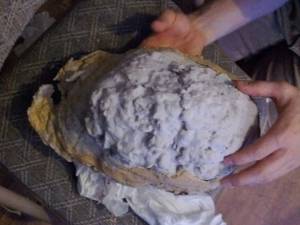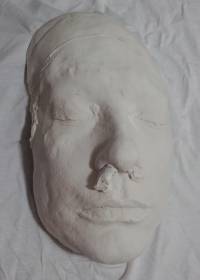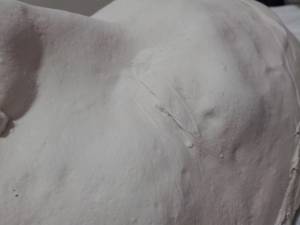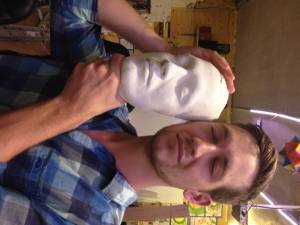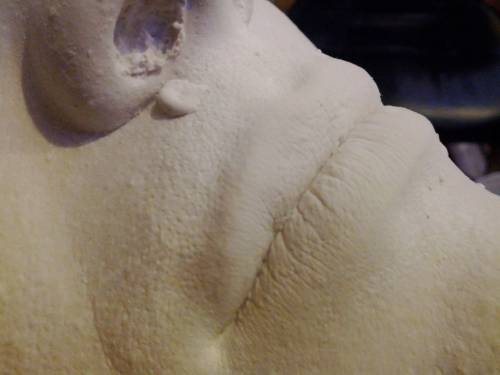hacks:face_casting
Table of Contents
Face casting
Contact: Alan Bucior
You can get an idea of the overall process here.
Best practices
Step 1: Prep
- Make sure you have a lot of space and nearby access to warm water and a garbage can.
- Hair should ideally be covered by a swim cap. Hair that still shows should ideally be covered with some sort of release agent such as Vaseline, but short hair seems to pull away without much of a problem.
- The rest of the body should be covered with a plastic dropsheet or similar.
- Alginate will get on the floor. It's easy to clean up if it's a hard floor. Carpet would be a disaster.
- Pre-measure everything and have mixing bowls ready.
- Have warm water on hand.
- Have lots of paper towel handy.
- Pre-cut all your plaster/bandage strips.
Step 2: Alginate
- We use Alji-Safe from Smooth-On. This is available in town from Fibertek.
- We've tried Alji-Safe Acrobat, but found it too lumpy. It may be usable if you use a Jiffy Mixer to mix it smoothly.
- Alginate is mixed 1:1 with warm water by volume.
- One face requires about 2-2.5 plastic disposable cups worth of alginate.
- It sets up quite quickly (~5 min), and I think it sets up quicker the warmer the water. One person can do it if they move fast. Ideally two people so that one can concentrate on detail bits like the nose while the other concentrates on the edge areas like the chin and forehead.
- Apply a thin coat of alginate to the face first. Bubbles often form in the eye sockets where it meets the nose. Assume there's going to be air bubbles in there and apply a light coat first to the eyes, scooping the air bubbles out. Also be sure to smooth out bubbles in facial hair stubble.
Step 3: Plaster & Bandages
- Pre-plastered bandages were bought from an art store. (Opus has them, or Fibertek)
- They just need to be dipped in warm water and applied.
- Mostly larger strips work better but a few small strips are needed for around the nose.
- Ideally two layers of bandages for coverage.
- This whole step is easy and fairly error-proof.
Step 4: Casting
- Plug the nose holes!
- Our casting medium of choice is HydroStone TB. This is available in town from Fibertek.
- The mix ratio is 32:100 water:hydrostone by weight, which is a bit less than 1:2 by volume. We measured 1 plastic cupfull of hydrostone, measured it, then filled a cup to the appropriate weight with water, and marked that off with a Sharpie, and then marked off another line doubling the water for 2 cups worth of hydrostone. This allows us to easily get very accurate proportions without a scale.
- Water should be at 27 degrees C, or just a bit warm to the hand.
- About 5 plastic cups is appropriate for a full face cast.
- Hydrostone's data sheet says it must be mechanically mixed, but we've had excellent results with just hand mixing with a wooden spoon, for example. That said, it should be mixed for a decent amount of time. At least 3-4 minutes. You'll notice it start to get a bit creamier after a few minutes and this is a good indication that it's ready. The longer you mix, the faster it will set (much faster, actually. Mix time + set time is NOT constant when you increase the mix time).
- Goes hard in 15 minutes. Can demold in about 35 minutes!
Post-mortems
Face cast 1
Amounts
- Alji-safe: 2 cups and 2 cups water. Perhaps could use a bit more
- Ultracal: 2.5 cups, with 1 cup water. Definitely need more for a deeper cast, and probably a bit less water. Probably something like 3.5 cups to 1 cups water.
Issues
- Not deep enough
- Next time we'll try to get more depth by casting more of the face and forehead.
- Nose detail poor
- Next time I think we should try using straws in the nose to be able to cover more of the skin of the nose. Also, breathing out seemed to push away the alginate and bandages. By pushing the air through straws we may be able to mitigate that.
Face cast 2
Amounts
- Alji-safe: 3 cups and 3 cups water. Way too much. 2.5 cups next time? Or maybe just 2 is good enough.
- Ultracal: We didn't measure it and just eyeballed it, which was fine (EDIT: No, it was not fine. Mix accurately next time). Mixed for consistency.
Results
- We concentrated on getting good depth and we used a swimming cap. We got great depth and decided to do the ears, but the ears were totally unnecessary and rose way above the usable depth. Next time concentrate on getting more of the forehead and less of the ears.
- We used straws in the nose and that worked fairly well. Though it left two small very round holes. I think rolled paper might work better as it'll better conform to the shape of the nose.
- A few bubbles on the face, but those can be fixed up.
- I'm concerned that the Ultracal isn't giving enough fine detail. It should be performing better, but it seems like a thin outer layer sloughs off when you demold. Perhaps we should try plaster next time. I've also heard good things about Hydrostone, so maybe we should try that.
Face cast 3
Amounts
- Alji-safe Acrobat: 2.5 cups. About right. Could even do just 2 cups. Seemed too lumpy. Needs mechanical mixing.
- Hydrostone: 4 cups, measured water very accurately. Was a good amount, but could have gone even deeper. 6 cups would get lots more depth.
Results
- We used a swimming cap, and marked a straight line on the head with tape to make we didn't go too high in parts and too low in others. We didn't do the ears.
- We used paper tubes in the nose and that worked fairly well. But when we cast the head we forgot to plug the nose resulting in plaster protrusions.
- A few bubbles on the face in the eye socket area where it meets the nose. Next time try scooping that area. Also try wetting the face first.
- Hydrostone worked awesomely.
- I checked the docs a bit more. Smooth-on recommends using a Jiffy Mixer or Turbine Mixer attachment on a drill to get a smooth product with Acrobat. I’ll pick one up this weekend. I think ICI Paints has them.
- We should make sure in the future to apply a light coat to the eyes and scoop out any air bubbles before adding more.
- Interestingly, Smooth-On recommends wetting the skin before applying alginate. Perhaps that helps with air bubbles?
- I’ve noticed that every time, our plaster gauze cast goes from very hard to very soft as it gets further wetted from the alginate. We might try a few things:
- More plaster gauze. At LEAST 2 layers. Maybe 3
- Maybe try a different brand. I think Fibertek has some medical grade stuff. We can try that.
- Maybe we put a layer of plastic wrap between the alginate and the cast after de-mold.
Face cast 4
Amounts
- Alji-safe Acrobat: 2.5 cups. Perfect.
- Hydrostone: 5 cups (2750g), measured appropriate water very accurately. Perfect.
Results
- Near perfection. Perfect detail. Only a few air bubbles in the chin area, where facial hair stubble probably trapped some air. Next time make sure to smooth down stubbly areas.
- Smoothing out the eyes worked perfectly.
- Seems like an initial thinner layer of alginate over the face works well to reduce slumping, remove bubbles, and preserve detail.
- Nose holes plugged with alginate. Worked well.
- Hydrostone one again worked awesomely.
- Still issues with plaster gauze not going 100% hard. Need to research whether gypsona would work better.
hacks/face_casting.txt · Last modified: 2015/12/12 14:31 by 127.0.0.1


